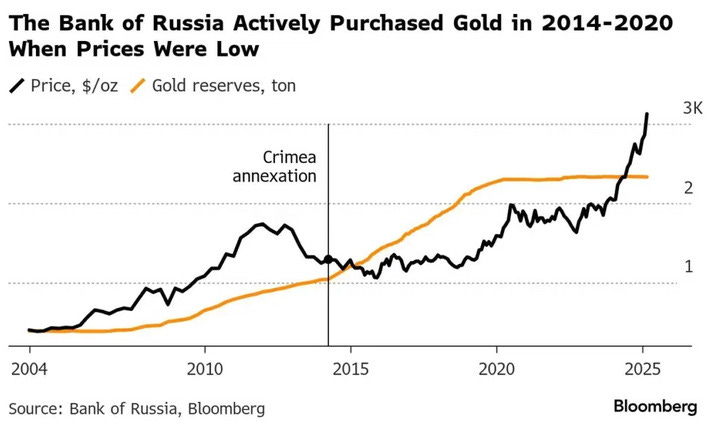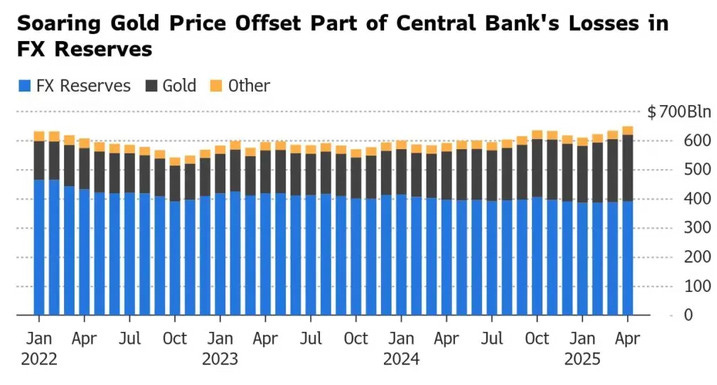Russia’s Gold Strategy Offsets Sanctions Freeze
The Russian gold hedge uniquely ties together two concepts championed at Goldfix for years:
i. China is using Gold to replace USD in commodity trade thus soft-backing its money using convertibility optionality and…1
ii. Deglobalization begets Mercantilism as willing participants use gold to continue doing trade and thus stave off global war.2
Even so, the world still does not (or cannot) admit that the USD is being replaced, and that Gold, hated for decades, is actually the thing keeping the world together right now. Now, the empirical evidence is coming in, by no less journalistic stalwarts than Bloomberg.
Here is a breakdown of that evidence.
Bottom Line
Russia’s longstanding accumulation of gold has become a strategic buffer against Western sanctions, offsetting nearly one-third of the central bank’s frozen reserves. Despite holding steady at around 75 million ounces since 2020, the surge in global gold prices has boosted the value of Russia’s gold by $96 billion since 2022. With over $229 billion in bullion, Russia now ranks among the top five global reserve holders. While gold remains less liquid than other assets, rising global demand strengthens its utility in a crisis. The strategy reflects a broader pivot away from Western financial exposure and toward monetary self-reliance.
Strategic Gold Accumulation: From Crimea to Conflict
The current value of Russia’s gold stockpile reflects not a recent acquisition, but the product of a calculated accumulation strategy initiated in 2014 following the annexation of Crimea. In response to initial sanctions and removal from the G8, the Bank of Russia began diverting reserve growth into physical bullion. Between 2014 and 2020—when gold traded between $1,100 and $1,500 per ounce—it increased holdings by approximately 40 million ounces.
This reserve pivot has yielded a 72% surge in gold valuation since early 2022, according to Bank of Russia data. Though the physical quantity remains near 75 million ounces, the monetary value of these holdings has climbed by $96 billion. As of April 1, Russia’s total international reserves stood just shy of $650 billion.
A Hedge that Worked
The strategic rationale was threefold, as summarized by Bloomberg Economics’ Alex Isakov:
Diversify reserves away from dollar, euro, and sterling risk.
Bolster ruble liquidity via domestic bullion exchange.
Support domestic gold producers with predictable demand.
In practice, the diversification has delivered. With roughly $322 billion of Russia’s foreign currency reserves frozen abroad following the 2022 Ukraine invasion, the appreciation of gold provides a partial offset—covering nearly one-third of the blocked funds.
Liquidity in a Geopolitical Bind
Despite its hedging value, gold’s illiquidity remains a concern. Tatiana Orlova of Oxford Economics notes that bullion lacks the transactional flexibility of U.S. Treasuries or eurozone bonds. However, she acknowledges that elevated global demand for gold improves its potential role as a liquid asset in the event of a balance-of-payments emergency.
Still, selling appears unlikely. The Bank of Russia, constrained by sanctions and wary of counterpart risk, indicated in its March annual report that investment opportunities in foreign markets remain limited due to “risks inherent in their economies, currencies and financial markets.” For now, gold is to be held—not deployed.
The Golden Yuan Rises
Post-invasion, Russia’s central bank ceased disclosing the composition of its foreign reserves. But previous disclosures and Bloomberg analysis suggest a bifurcated structure: approximately half in Western currencies (now blocked), and the remainder in yuan and gold—both accessible.
Trust, Mercantilism, and Why We Need Gold
Housekeeping: There is a large free excerpt and much of the written portion is accessible. Everyone of us was right. People need to know the way forward. This may help. Please share this one. Thank you.
Renaissance Capital’s Oleg Kuzmin confirms as much:
“There is no need to spend reserves now. The Bank of Russia has enough liquidity in yuan in case of any shocks.”
In this context, the yuan serves as transactional liquidity while gold functions as deep reserve collateral.
Bullion’s Bull Run and What It Means
Gold’s recent rally has compounded Russia’s strategic advantage. Bullion touched a record $3,167.84 per ounce last Thursday before retreating slightly, amid rising geopolitical tensions and a renewed wave of U.S. tariffs under President Trump. Since end-2022, gold has returned over 27%—well above most asset classes.
In the event sanctions are lifted, and the $322 billion in frozen assets returned, the Kremlin would command a financial position of unprecedented strength. In the alternative scenario—where those reserves are never recovered—gold remains a durable fallback.
Sanctions-Resilient Reserve System
Russia’s preemptive accumulation of gold has proven more than symbolic. It represents a structural shift in reserve policy—one aimed at insulating monetary sovereignty from Western financial leverage. Though gold alone cannot replace liquid fiat assets, its rise in value and geopolitical neutrality make it a formidable shield.
(see 2017’s Golden Yuan: Crude Backed By Gold is Here)










Yep!
"Support domestic gold producers with predictable demand." Eventually that trend will arrive in the U.S mining sector following the return to mercantilism VBL model.